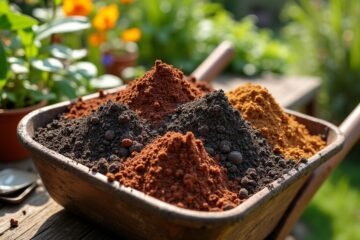Caring for your raised bed garden is like composing a beautiful symphony! Start with a rich soil mix of compost, peat moss, and vermiculite for happy roots. Water daily with a drip system, so your plants don’t feel thirsty. Keep pests at bay with friendly ladybugs and natural barriers. Don’t forget to mulch—it’s like a cozy blanket for your plants! If you want to discover more tips for a thriving garden, keep exploring this joyful journey!
Choosing the Right Soil Mix

When it comes to your raised bed garden, picking the right soil mix can feel a bit like choosing the perfect ice cream flavor—so many delicious options! You want a fantastic soil composition that strikes the perfect balance between rich nutrients and airy texture. A blend of compost, peat moss, and vermiculite can work wonders. Think of it like a cozy blanket for your roots!
Don’t forget about drainage solutions, either—nobody wants soggy plants! Incorporating perlite or gravel helps prevent your beautiful blossoms from drowning. Imagine your plants thriving in the best environment possible. So, roll up your sleeves, mix it up, and create that dreamy soil your garden deserves! Ready to dig in? Let’s get mixing!
Watering Techniques
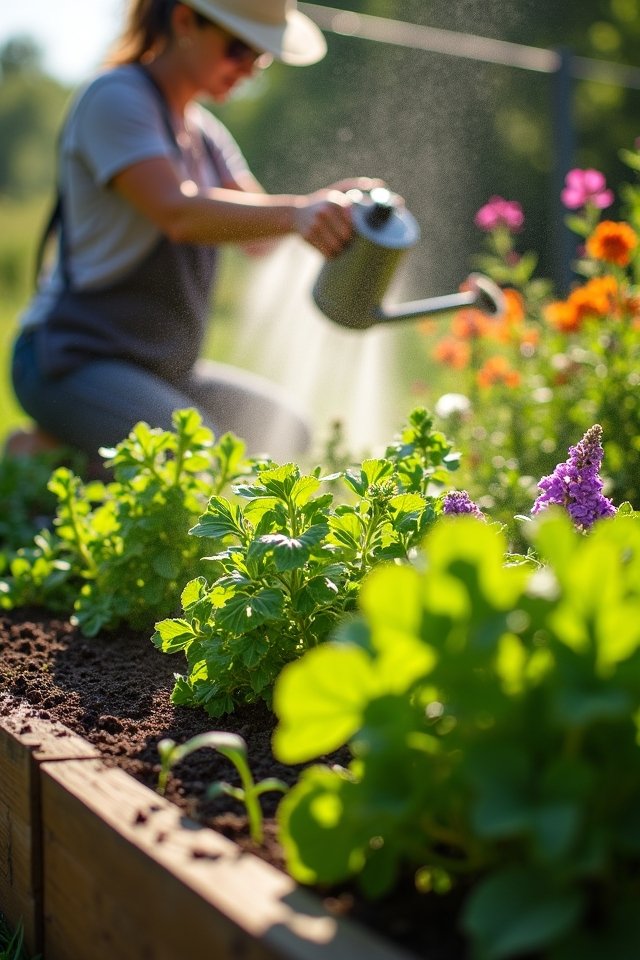
While your plants dream of sunshine and growth, they depend on you for their hydration needs! One of the most innovative watering techniques is drip irrigation. Imagine tiny droplets dancing around each plant’s roots, delivering just the right amount of moisture while minimizing waste! This method not only guarantees perfectly hydrated plants but also boosts moisture retention in your raised beds.
Try using a soaker hose or drip tape for ease of use; it’s like giving your plants a gentle shower every day! Don’t forget to check moisture levels, too—feel the soil! With a little attention, your garden will thrive like never before. After all, happy, hydrated plants lead to bountiful harvests! What’s not to love?
Pest Management Strategies
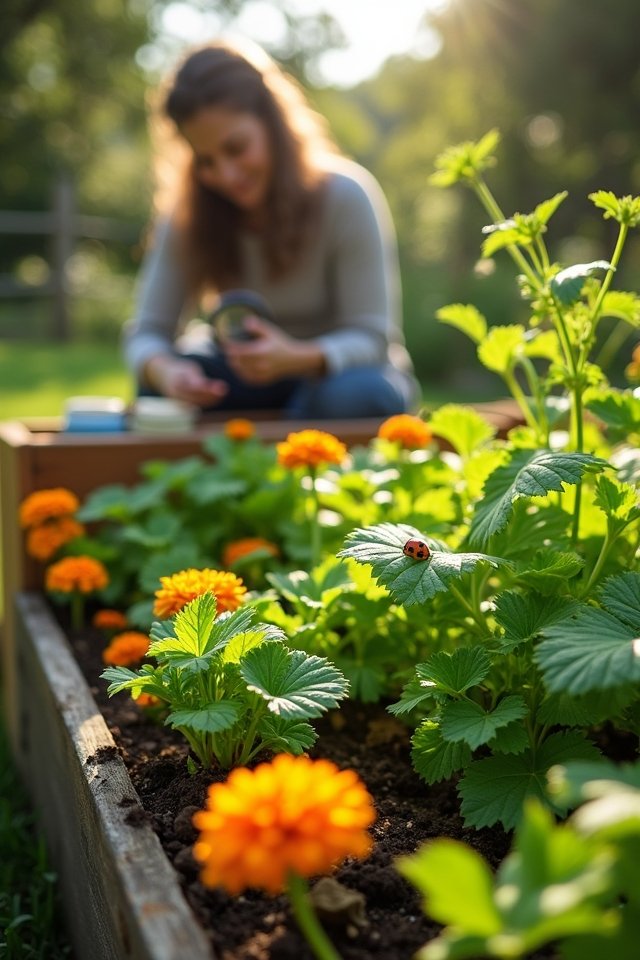
Even if you think your raised bed garden is thriving, it can turn into a bug banquet if you don’t manage pests effectively! Think of it as inviting a party-crasher who just won’t leave. One innovative strategy is using natural predators like ladybugs and lacewings—they’re like the superhero squad for your plants! Plus, consider companion planting; for example, marigolds fend off pesky nematodes while providing a splash of color. Who wouldn’t want that? You could also create barriers with floating row covers, keeping unwanted guests away without chemical interventions. So, take some proactive steps! Adopt these pest management strategies to guarantee your garden stays a thriving sanctuary, not a buffet for critters! Who knew gardening could be such a thrilling adventure?
Fertilization and Nutrient Management
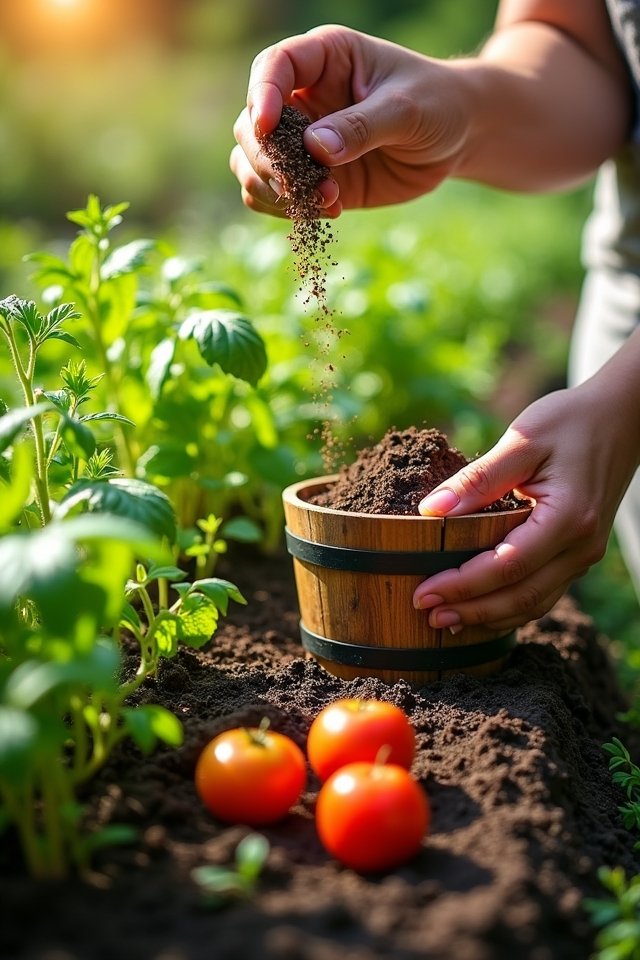
To keep your raised bed garden flourishing, you need to treat it like a high-maintenance friend—especially when it comes to fertilization and nutrient management! Think of compost application as a warm hug for your soil. Regularly incorporating rich, dark compost boosts essential nutrients, giving your plants a delicious feast. But don’t skip soil testing! It’s your garden’s way of whispering its needs. Just like checking your friend’s mood, soil testing reveals what nutrients are missing or abundant. You wouldn’t want to overfeed your basil or starve your tomatoes! So, grab that soil test kit and let your garden thrive with the perfect balance of nutrients and love. After all, a vibrant garden is a happy garden!
Crop Rotation Practices

When you rotate your crops, you’re not just being clever; you’re throwing a fabulous party for your garden! This dynamic dance prevents pests and diseases from crashing the bash. Think of cover crops as the warm-up band, enriching your soil and improving its structure. Have you tried companion planting? It’s like inviting the right guests; tomatoes and basil make a fantastic duo that enhances flavors and deters insects! Mix it up each season to keep your soil vibrant and nutrient-rich. If your carrots took the stage last year, let peas take the spotlight now. Just like a well-planned event, strategic crop rotation leads to a healthier, thriving garden. You’ll be amazed at the growth and harvest you’ll reap!
Weeding and Mulching
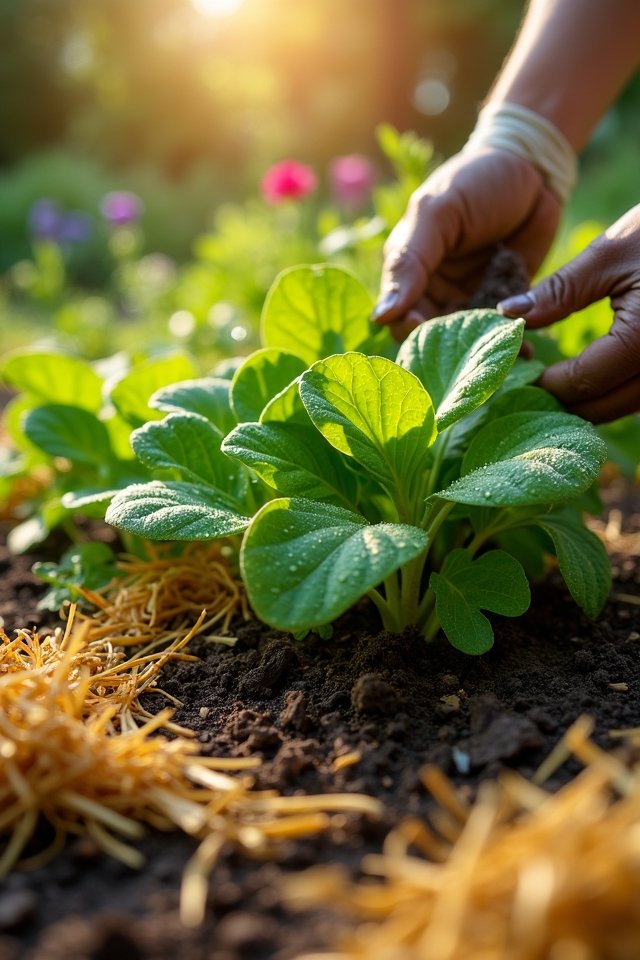
While a beautiful garden can make your heart sing, nothing can derail that harmony quite like weeds crashing the party! First, tackle weed identification to distinguish those pesky intruders from your prized vegetables. Think of it as a garden detective mission! Regularly check for weeds, pulling them by the roots to keep your plants thriving.
Next, don’t underestimate mulch benefits! A cozy layer of organic mulch not only suppresses those weeds but also retains moisture and enriches your soil. Imagine a protective blanket wrapped around your garden, staving off unwanted guests while keeping it cozy! Aim for a two- to three-inch layer, and your plants will thank you with vibrant growth. So, let’s get weeding and mulching! Your garden deserves it!
Seasonal Preparation and Cleanup
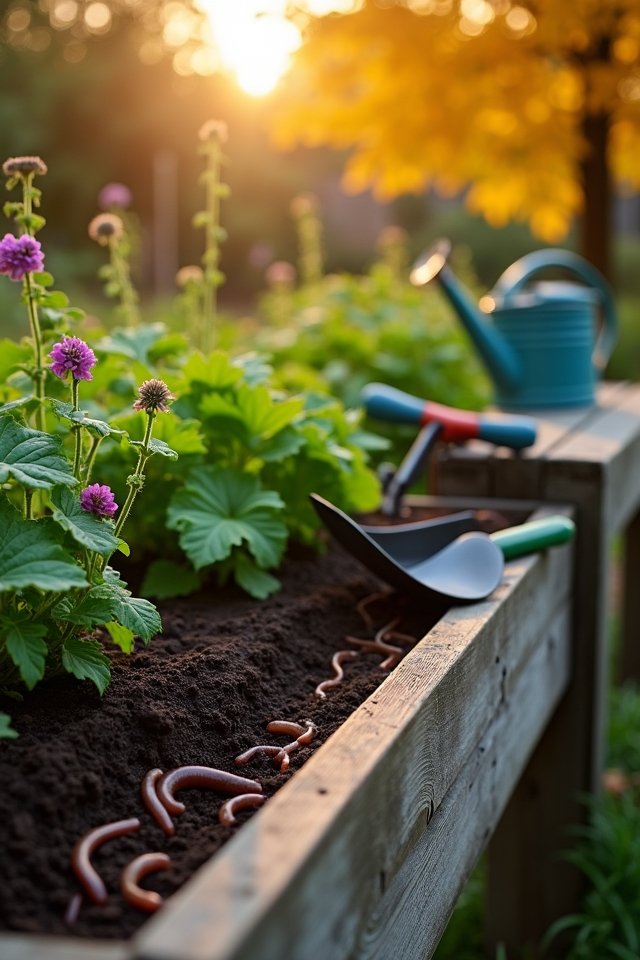
As the seasons shift, your raised bed garden needs a little TLC to guarantee it thrives through every weather whim! For spring preparation, kick things off by turning your soil and incorporating compost—think of it as giving your garden a nutritious breakfast! Add in some organic fertilizer to really rev up those plants.
When fall rolls around, it’s your time for a cozy cleanup. Pull out dead plants and old weeds like they’re last summer’s fashion! Consider planting a green manure crop to enrich the soil during winter—it’s like sending your garden to a spa! Finish up by layering mulch to protect your soil from the icy chill. Your raised bed will be beautifully primed for the next season’s growth!
Frequently Asked Questions
How Deep Should My Raised Bed Be for Optimal Plant Growth?
You’ll want your raised bed to be at least 12 inches deep for ideal plant growth! This perfect depth allows roots to spread wide, like a dancer twirling freely. Deeper beds up to 18 inches can promote even better root growth, giving your plants the space they crave. Remember, happy roots mean vibrant plants! Think of it as giving them a cozy apartment to thrive in. Isn’t gardening just the best?
Can I Use Untreated Wood for Building Raised Beds?
Can you really use untreated wood for your raised beds? Sure, but think of it like playing with fire! Untreated wood can rot faster than your grandma’s meatloaf if it’s exposed to moisture. Consider innovative wood alternatives like cedar or recycled plastic—both are durable and eco-friendly! Plus, they keep pests at bay. You’ll enjoy a vibrant garden without worrying about splinters or decay. Welcome creativity with sustainable materials, and watch your plants thrive!
What Plants Are Best Suited for Raised Bed Gardens?
You’ll love how vibrant your raised bed garden can be! Think of companion planting as forming a natural team—like Batman and Robin! Pairing tomatoes with basil not only maximizes space but also enhances flavor. Don’t overcrowd your plants; give them room to stretch, like kids on a playground! Carrots and onions enjoy each other’s company too. With proper plant spacing, you’ll cultivate a thriving, colorful oasis that’ll delight your senses and spark joy in every bite!
How Do I Prevent Soil Erosion in My Raised Bed?
Did you know that 25% of soil can wash away with heavy rains? To prevent soil erosion in your raised bed, apply a thick layer of mulch—like a cozy blanket for your plants! It’ll hold moisture, reduce runoff, and keep those nutrients snug. Also, consider using clever drainage solutions, like creating small trenches around your beds. Imagine your plants dancing in the rain, safe and sound—who wouldn’t love that? Happy gardening!
Is It Necessary to Cover My Raised Bed in Winter?
Is it necessary to cover your raised bed in winter? Absolutely! Think of it as a cozy blanket for your soil. It helps prevent frost damage, keeping your precious plants and microbes safe from nasty chills. You can use burlap, floating row covers, or even leaves! Not only does this add a snazzy look to your garden, but it also protects against soil erosion. You wouldn’t want your plants to freeze, would you?

